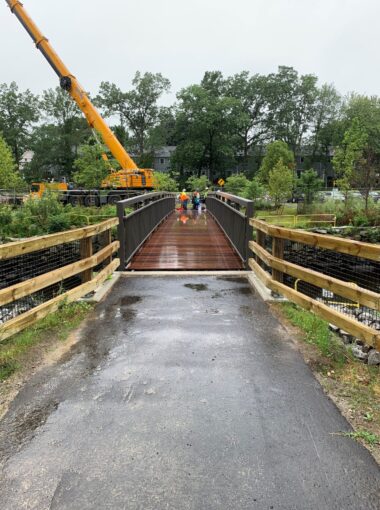Concord River Greenway Park
Visit
51 Davidson Street, Lowell, MA
The Greenway is open to the public for multi-use recreation (no motor vehicles). The Greenway is accessible to wheelchairs, strollers, and walkers.
Parking: Parking is available on Davidson Street (across from the Lowell Memorial Auditorium) or at Lawrence Street (near the entrance to the Lowell Cemetery)
Experience the Beauty of Lowell’s Hidden Jewel
Concord River Greenway brochure (en espanol)
The Concord River is a scenic, natural, cultural, and historical resource of national importance. Its natural beauty amid the City of Lowell is like a hidden jewel providing serenity and retreat from our modern lives. The Concord River Greenway Park is a multi-use recreational trail, owned and managed by the City of Lowell.
The Lowell Parks & Conservation Trust has been an active partner in the creation of the Greenway since 2000, providing public outreach and value-added elements such as multi-use signage, public art, and an outdoor classroom curriculum. This linear park will primarily follow an abandoned railroad right-of-way paralleling the river.
The Greenway – As Part of the Regional Trail Network
The Concord River Greenway will connect the city’s largest open spaces, Shedd Park and Rogers Fort Hill Park, to the center of the city and a network of walkways that have been developed by the City of Lowell and Lowell National Historic Park.
Please NOTE that while the Greenway is under construction, there are two sections open to the public. Please see the ‘directions’ tab at left for more details; this describes two sections where there is parking.
The Concord River Greenway is also an integral part of the Bay Circuit Trail and Greenway, which is a network of trails around greater Boston, from Duxbury on the South Shore to Plum Island on the North Shore. Stewardship, land protection, and trail maintenance for the Bay Circuit Trail is coordinated by the Bay Circuit Alliance.
A long-term vision for the Greenway is to connect to the Bruce Freeman Rail Trail, where it currently ends at a tunnel under Route 3 (CrossPoint Towers). The Bruce Freeman Rail Trail currently extends eight miles from Chelmsford to Westford. Construction is underway to connect the trail through Concord and eventually Framingham (25 miles total)
The project seeks to:
-
Preserve the natural beauty and character of the Concord River
-
Preserve the historic corridor that includes mills, dams, and an arch bridge, and is the famed section of the river that Henry David Thoreau portaged due to its rapids.
-
Provide a safe, viable transportation alternative between Lowell’s neighborhoods and downtown.
-
Provide a missing link in the Bay Circuit Trail, a 200-mile trail from Plum Island to Kingston, and connect to the Bruce Freeman Rail Trail from Lowell to Framingham.
-
Connect Lowell’s largest open spaces, including Rogers Fort Hill Park and Shedd Park, with Lowell Cemetery and the city’s cemeteries.






















